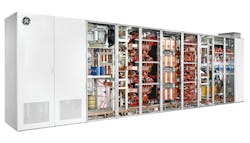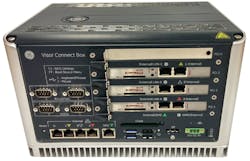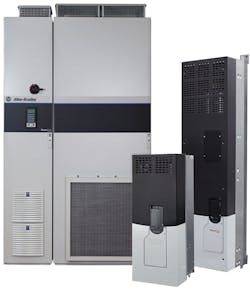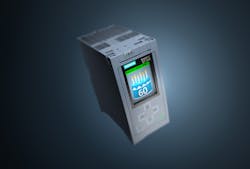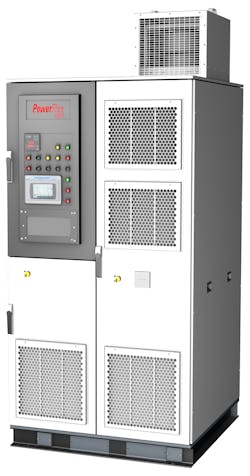The growth of advanced computing power embedded in a growing number of devices is changing the face of automation, and variable frequency drives (VFDs) are a big part of this trend. Capable of controlling motors by varying the frequency and voltage of their power supply, VFDs can improve energy efficiency; reduce unnecessary mechanical strain; and calibrate torque, speed, and power to best suit process requirements. Moreover, as intelligence has migrated from centralized programmable logic controllers (PLCs) into decentralized VFDs, new functionality—such as networking and diagnostics—has made them an invaluable asset.
According to Craig Nelson, senior product manager for Siemens Digital Industries Software's motion control unit, the shift toward smarter VFDs first began in the 1990s, when PLCs required a substantially greater investment and limitations in communication between drives and controllers created latency and performance issues. Since then, falling prices on PLCs—which are increasingly viewed as a commodity product—and faster communication capabilities have reversed the trend to some degree, but the intelligence capability of VFDs remains and has substantial value to offer.
However, like any business decision, choosing to either utilize a decentralized VFD with embedded controls or a centralized PLC involves weighing the pros and cons of each approach.
“People don’t design assets on an island anymore. It’s all about systems and what can be done to make a business run more efficiently, not what drive or controller do I pick,” says Aussie Schnore, principal engineer at GE Global Research. “It’s not about what product I get, but how I can use it to run my business more effectively.”
Decentralized VFD applications
VFDs allow operators to limit failure points and reduce downtime. While they may still be connected to a network for monitoring purposes, their ability to continue operating even if a cable or other external system goes down, means that operations can ultimately continue unimpeded.
“Say something happens to your network cable that you’re using to control the device. That’s one failure point that you’ve added because you’re using a controller. Now, the device stops and you have to go fix that cable, but if it’s just a monitoring point, the drive will continue to run and do its function,” says Mike Harris, senior commercial engineer for power and motion at Rockwell Automation. “When I was going through engineering school, one of the things that was drilled into me was, ‘If it’s not there, it can’t fail.’ So, keeping things simple and using less components makes things more reliable.”
But while the decision is clear-cut in these straightforward, isolated applications, evaluating the options for a line scenario—where each step of a workflow is dependent on other devices—becomes substantially more complicated. For example, while a VFD with embedded controls may be useful for a bottle filling application where an accumulation of products on a conveyor belt could continue to be processed even if filling ceases, it would be less effective in a continuous flow operation, like paper-making, in which each step must remain synchronized with those that come before and after it.
“Typically, if it’s a system or a line where things are working together, you’ll want a PLC to coordinate. The big difference is whether or not the drives are tied together or can stand alone,” says Harris. “If a section of a line is not dependent on other sections of the line, we want to keep that running, even if it means we have to bring down the upstream device where another controller is.”
Potential drawbacks
In theory, greater interconnectivity between drives enabled by the Industrial Internet of Things (IIoT) could alleviate these challenges, but the question then arises as to whether or not such an approach is necessary, practical, or cost effective.
For one, as drive intelligence, control capabilities, and interconnectivity increase, so will price. As a result, those considering decentralized control options will need to decide whether or not foregoing a PLC offers enough benefits to offset the higher upfront cost of purchasing an advanced drive.
“Nobody sells an advanced drive for free,” says Andrew Brodie, process measurement and control global marketing leader at Honeywell Process Solutions. “There’s always the question of ‘should I get a basic drive and a small PLC?’, or ‘do I get a more advanced drive?’ because when you get down to the nuts and bolts of it, whether it’s the drive vendor or the PLC vendor—somebody’s paying for that extra processing power.”
In addition, interoperability issues between drives from different vendors could present barriers to integration, according to Randal Rausch, engineer at GE Global Research’s embedded computing group. When employing a centralized PLC, communication protocols are standardized and programming takes place in one location. However, in multi-vendor setups, dividing up control logic and distributing it among elements that use different standards could be a challenge.
“If I’ve got a network of 30 VFDs, can I manage all 30 of them through one piece of software, or do I need to manage them one by one?” says Brodie. “PLC vendors have been doing that for 20 or 30 years, but for a drive vendor, it may be a case of needing to treat them like 30 small controllers, and therefore managing 30 small applications.”
Industry consensus
Roadblocks aside, decentralized control can offer myriad benefits. VFDs with embedded control can result in significant space savings as well as reducing the material and labor costs associated with running cables to a control cabinet. Not only that, but they may lend themselves well to certain high-precision applications, such as robotic motion control, that require extremely rapid response times. Even with automated guided vehicles or autonomous mobile robotics, the need to maintain a small footprint may encourage the use of smarter VFDs.
When it comes to interoperability issues, some answers from industry have begun to emerge. The OPC Foundation’s Unified Architecture, for instance, promises to create a shared and open standard by which various devices can more easily communicate.
Still, according to Schnore, there is no cut-and-dry answer as to whether or not end-users should aim to reduce reliance on centralized control. Far more important is examining the unique offerings of individual vendors, as well as making lifecycle considerations such as the challenges of integration or the potential costs of retraining staff to work on new equipment. In addition, as we move forward, the division between centralized PLC control and decentralized VFD control may represent an increasingly outmoded dichotomy. Rather, in the era of IIoT, it may be more prudent to ask how smarter devices, of all types, can best be used to extract value and improve overall business operations.
“What it really boils down to is that you need the capability to have both centralized and decentralized control,” Nelson says. “I would say the trends most recently have been to put more smarts in the PLC and less in the drive, but there are still a lot of applications where the drive having its own intelligence is going to be the preferred solution.”
Similarly, even when a PLC is maintained for control, intelligence for monitoring equipment health and performing other analytics can be provided by a VFD with greater embedded processing power.
Given the current state of the industry, the question for technology suppliers is: What is the motivation for the manufacturer of a VFD to put control logic into a device?
“We’re saying, hey, we’ve got the capability to do control of this item, but we also have another core. We have processing power sitting there and potentially not delivering any value,” Rausch says. “Why not turn that into some form of value? Extra control functionality would be one way of doing it, but we can also [use it for] analytics, gateways to the internet, logging, and other functionality that can offer additional layers of security.”
So, while the increase in computing power housed in VFDs certainly makes them capable of more decentralized control, outside of a few niche applications the broader share of industry won’t be in the position to ditch their central PLC brains anytime soon. Even so, the expanding capacity of VFDs to deliver value from data will continue to be a boon to the manufacturing industries.
About the Author
David Miller
Former Senior Technical Writer

Leaders relevant to this article:

